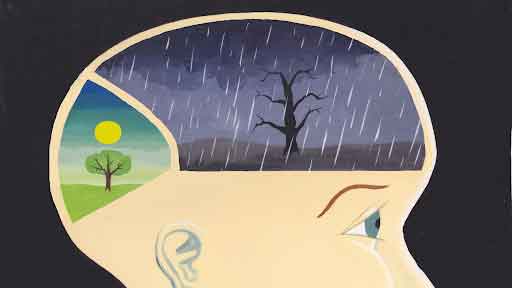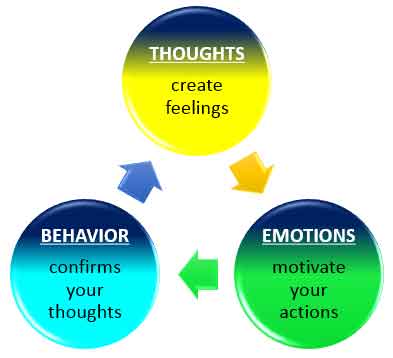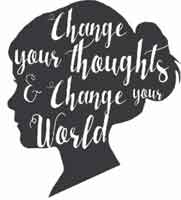Learning to Conquer Negative Thinking
January 28, 2021
By: Lindsay Fletcher, Ph.D., NCSP | Psychology Manager, Bridgeway Academy
Negative thoughts are a tricky lot. Sometimes, they are a quiet voice that whispers in the background even when you’re trying to stay optimistic. Other times, they shout so loudly that they’re hard to ignore. This shouting may even shape how we view others and the world around us. This is a topic that Bridgeway Academy’s Psychology Department tackles on a daily basis with our therapy clients, so we thought we’d share a couple of our tried and true approaches that are effective for children, adolescents, and adults alike!

Cognitive Behavioral Therapy, otherwise known as CBT, is an approach based on the reciprocal relationships among thoughts, emotions, and behaviors. From this perspective, one’s immediate interpretations of events are referred to as “automatic thoughts” because they occur spontaneously. These automatic thoughts shape how an individual feels about the event/person/world, and then this shapes the subsequent actions, or behaviors, they take in response to their feelings. These actions typically confirm the thoughts the individual had to begin with which fuels the continuation of these patterns (Freeman, Pretzer, Fleming, and Simon, 2004).

It’s easy to understand how one gets caught up in negative patterns of thinking. Not only do negative world events impact us daily (we’re talking about you, 2020…), it’s also very common to use inaccurate language in our daily lives. How many times have you said someone was “the best” when they did a mundane task for you or “the worst” for a minor (or even comical) infraction? Or, how often have you told someone “You’re hilarious!” or typed “LOL” while barely cracking a smile on your face? Our language has become quite dramatic in the present day, and you’d be hard pressed to find someone who didn’t raise their hand for at least one or more of those examples (psychologists included!). Inaccurately labeling the world around us is a stone’s throw away from misinterpreting situations and creating negative thought patterns as a result.

For the purpose of this blog, we thought it would be helpful to explore a couple of the kinds of automatic thought patterns, also known as cognitive distortions, that can lead individuals to inaccurate conclusions about events. While there are many more examples we could talk about, here are 5 of the most common ones:
All or Nothing Thinking: Also referred to as black and white or polarized thinking, is when things are seen in terms of one or the other with no shades of gray in between. Example: Believing that one is either a success or a failure, and that anything short of a perfect performance is a total failure.
Catastrophizing: Negative events that might occur are treated as intolerable catastrophes rather than being seen in perspective. Example: You get a C on a single test in high school, which must mean you’ll never get accepted to the college of your choice and then you’ll never get the career you want because you won’t have the right college background.
Personalization: Assuming that one is the cause of a particular external event when, in fact, other factors are responsible. Example: Assuming that your supervisor’s unhappy demeanor is evidence that she doesn’t like you, but you never stop to ask her what is wrong (when in fact she just found out her mother is in the hospital).
Overgeneralization: A specific event is seen as being characteristic of life in general rather than being one event among many. Example: Assuming that you will never be good at math just because you struggled to learn one concept on that one day.

Disqualifying the Positive: Positive experiences which would conflict with the individual’s negative views are discounted by declaring they “don’t count.” Example: Disbelieving positive feedback from friends and family by thinking, “They’re only saying that to be nice.”
For many, one or more of these cognitive distortions will look familiar because you personally may fall into one or more of these traps or know someone who does. While we all experience negative thinking from time to time, once these patterns start taking over day after day, it’s time to put some strategies in place to get yourself back on track. Here are two of the Psychology Department’s favorite tools to use with clients who are struggling with negative thought patterns:

Track Your Automatic Thoughts: The first step is to catch yourself having the automatic thought, and the second step is to write them down on what is often called a “thought record.” Tracking what kind of situation triggered the thought, the emotion you felt, what the automatic thought was, and then attempting to correct that thought to be more rational is a great way to strengthen your ability to stop these distortions in their tracks! Example: Engage in a Behavioral Experiment: One of the most powerful ways to achieve cognitive change is to obtain evidence from personal experience that is incompatible with the negative thoughts. In other words- you don’t have to believe others when they tell you you’re wrong- go out and see for yourself! For example, if the automatic thought is: “I can’t make new friends. People will think I’m weird if I try to talk to them. This one time at the gym, I said ‘Hi’ to the person on the treadmill next to me, and they didn’t even respond. So, why even bother?” (overgeneralization).


Experiment Example:
– Automatic Thought: People will think I’m weird if I try to talk to them.
– Reason You Think That: This one time at the gym, I said ‘Hi’ to the person on the treadmill next to me, and they didn’t even respond.
– Rational Response: Maybe that person couldn’t hear me over their headphones.
– Experiment: Make eye contact with, smile at, and say “Hi, how’s it going?” to at least 5 people at the gym today. Take note of their response and acknowledge if they were wearing headphones and even heard me. Make a note (on paper or on a phone app) of how many people respond positively. Compare this number (likely 4-5) with the number you thought would smile back with a greeting (likely zero). Continue to gather “evidence” to refute the idea that everyone thinks you’re weird if you try to talk to them.If you’d like to learn more about the various types of cognitive distortions that have been researched over the years, check out these resources at psychcentral.com and goodtherapy.org. Sometimes, doing a little reading on your own can open your mind to patterns you didn’t realize you were engaging in, and then with a little information you can start to learn how to combat these thought patterns on your own. Other times, it may be helpful to talk to a professional who can help you transform your negative thoughts and beliefs into empowering affirmations that actually inspire and uplift you.References:
Freeman, A., Pretzer, J., Fleming, B., and Simon, K.M. (2004). Clinical applications of cognitive therapy. (2nd ed.). New York, NY: Kluwer Academic/Plenum Publishers.
20 cognitive distortions and how they affect your life. (2015, April 7). Retrieved from https://www.goodtherapy.org/blog/20-cognitive-distortions-and-how-they-affect-your-life-0407154